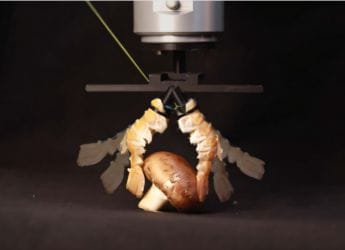- Home
- Science
- Science News
- Cambridge Team Uncovers Unexpected Quantum Behaviour in Non Metal Organic Molecule
Cambridge Team Uncovers Unexpected Quantum Behaviour in Non-Metal Organic Molecule
Researchers from the University of Cambridge have identified a surprising quantum behavior in an organic molecule called P3TTM.

Photo Credit: Wikipedia Common
Cambridge scientists discover a quantum effect in P3TTM, boosting solar power efficiency
In a feat of organic-meets-electronic chemistry, scientists at the University of Cambridge have observed this quantum effect in an organic molecule that had long been considered incapable of such behaviour, a feature only special to metals. They found that a carefully engineered small-molecule organic semiconductor can deliver almost all of the photons above the device work function as useful current, as nearly 98 per cent of photo-generated carriers are transported out of the active layer and eventually result in photocurrent response.
Quantum Behaviour in Organics
As per Science Daily, organic molecules don't follow metal-like rules of electron interaction. In the majority of organic materials, electrons come in pairs, and the members of a pair don't “talk” to one another's buddies. But in P3TTM, there is an unpaired electron on each molecule that can interact with electrons on neighbouring molecules.
At high density, the molecules downshift to Mott-Hubbard behaviour, a behaviour familiar from inorganic materials. This enables electrons to hop from one molecule to another, generating charge separation in one material.
Implications for Solar Devices
To see if the idea works in practice, the researchers constructed a simple solar cell using P3TTM. The device was nearly ideal under light, gathering about the charges — most were converted to electricity.
By comparison, standard organic solar cells use two different materials, which, between them, limit the efficiency of the device. Apart from this simplification, there is one more exciting reason to celebrate these results of ours: They have, in fact, been around all along! On a more speculative note, the senior author, Sir Richard Friend, tied the discovery to pioneering ideas from Sir Nevill Mott, who theorised about how electrons would interact in solids.
Get your daily dose of tech news, reviews, and insights, in under 80 characters on Gadgets 360 Turbo. Connect with fellow tech lovers on our Forum. Follow us on X, Facebook, WhatsApp, Threads and Google News for instant updates. Catch all the action on our YouTube channel.
Related Stories
- Samsung Galaxy Unpacked 2025
- ChatGPT
- Redmi Note 14 Pro+
- iPhone 16
- Apple Vision Pro
- Oneplus 12
- OnePlus Nord CE 3 Lite 5G
- iPhone 13
- Xiaomi 14 Pro
- Oppo Find N3
- Tecno Spark Go (2023)
- Realme V30
- Best Phones Under 25000
- Samsung Galaxy S24 Series
- Cryptocurrency
- iQoo 12
- Samsung Galaxy S24 Ultra
- Giottus
- Samsung Galaxy Z Flip 5
- Apple 'Scary Fast'
- Housefull 5
- GoPro Hero 12 Black Review
- Invincible Season 2
- JioGlass
- HD Ready TV
- Laptop Under 50000
- Smartwatch Under 10000
- Latest Mobile Phones
- Compare Phones
- Realme P4x 5G
- OnePlus Ace 6T
- Nubia Flip 3
- Nubia Fold
- OPPO A6x 5G
- Samsung Galaxy Z TriFold
- Poco F8 Ultra
- Poco F8 Pro
- Asus ProArt P16
- MacBook Pro 14-inch (M5, 2025)
- Poco Pad M1
- Poco Pad X1
- Just Corseca Skywatch Pro
- Honor Watch X5
- Acerpure Nitro Z Series 100-inch QLED TV
- Samsung 43 Inch LED Ultra HD (4K) Smart TV (UA43UE81AFULXL)
- Asus ROG Ally
- Nintendo Switch Lite
- Haier 1.6 Ton 5 Star Inverter Split AC (HSU19G-MZAID5BN-INV)
- Haier 1.6 Ton 5 Star Inverter Split AC (HSU19G-MZAIM5BN-INV)

















